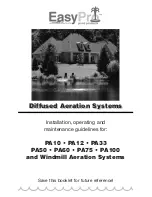
9
Installation Instructions
4. COLD WATER PIPE GROUNDING
CAUTION:
The house cold water pipe (metal only) is
often used as a ground for the house elec-
trical system, The 3-valve bypass type of
installation, shown in Figure 6, will maintain
ground continuity. If you use a plastic
bypass valve at the unit, continuity is bro-
ken. To restore the ground, do the follow-
ing:
a
. Install a #4 copper wire across the removed section
of main water pipe, securely clamping it at both
ends (See Figure 12) - parts not included.
NOTE:
Check local plumbing and electrical codes for
proper installation of grounding. The installa-
tion must conform to them. In Massachusetts,
plumbing codes of Massachusetts shall be
conformed to. Consult with your licensed
plumber.
5. INSTALL VALVE DRAIN HOSE
a
. Take a length of 5/8” inside diameter garden hose
and attach to the valve drain fitting (See Figure 7 on
page 7).
b
. Locate the other end of the hose at a suitable drain
point (floor drain, sump, laundry tub, etc.). Check
and comply with local codes. Refer to Figure 7 on
page 7 if codes require a rigid pipe drain run.
IMPORTANT:
Use high quality, thick wall hose that will
not easily kink or collapse. The filter will
not backwash properly if water cannot
exit this hose during recharges.
c
. Tie or wire the hose in place at the drain point.
Water pressure will cause it to whip during the back-
wash and fast rinse cycles of recharge. Also pro-
vide an air gap of at least 1-1/2” between the end of
the hose and the drain point. An air gap prevents
possible siphoning of sewer water, into the filter, if
the sewer should back up.
d
. If raising the drain hose overhead is required to get
to the drain point, do not raise higher than 8 feet
above the floor. Elevating the hose may cause a
back pressure that could reduce backwash flow and
proper mineral bed cleaning.
6. FLUSH PIPES, CIRCULATE DISINFEC-
TANT, EXPEL AIR FROM FILTER, AND
TEST YOUR INSTALLATION FOR LEAKS
CAUTION:
To avoid water or air pressure damage to
filter inner parts, be sure to do the following
steps exactly as listed:
a
. Fully open two cold, filtered water faucets nearby
the filter.
b
. Place bypass valve(s) into “bypass” position. On a
single valve, slide the stem inward to BYPASS (See
Fig. 7 on page 7). On a 3 valve system, close the
inlet and outlet valves, and open the bypass valve
(See Fig. 6 on page 7).
c
. Fully open the house main water pipe shutoff valve.
Observe a steady flow from both opened faucets.
d
. Place bypass valve(s) into “service”, EXACTLY as
follows. KEEP FILTERED WATER FAUCETS OPEN.
=
Single Bypass Valve:
SLOWLY, pull the valve
stem outward to ”service” position, pausing sev-
eral times to allow the filter to pressurize slowly.
=
3 Valve Bypass:
Fully close the bypass valve
and open the outlet valve. SLOWLY, open the
inlet valve, pausing several times to allow the fil-
ter to pressurize slowly. The sanitizing bleach
also circulates through the filter.
continued on next page
3. COMPLETE PLUMBING TO AND FROM
THE FILTER
Using the “Typical Installation Illustrations” on page 7
as a guide, observe all of the following cautions while
you connect inlet and outlet plumbing:
=
Be sure incoming,
unfiltered water
is directed to
the valve
INLET
port.
=
Be sure to install bypass valve(s).
=
If making a soldered copper installation, do all
sweat soldering before connecting pipes to the filter
fittings. Torch heat will damage plastic parts.
=
Use pipe joint compound on all external pipe
threads.
=
When turning threaded pipe fittings onto plastic fit-
tings, use care not to cross-thread.
=
Support inlet and outlet plumbing in some manner
(use pipe hangers) to keep the weight off of the
valve fittings.
FIG. 12
Ground Wire
Clamp (2)










































